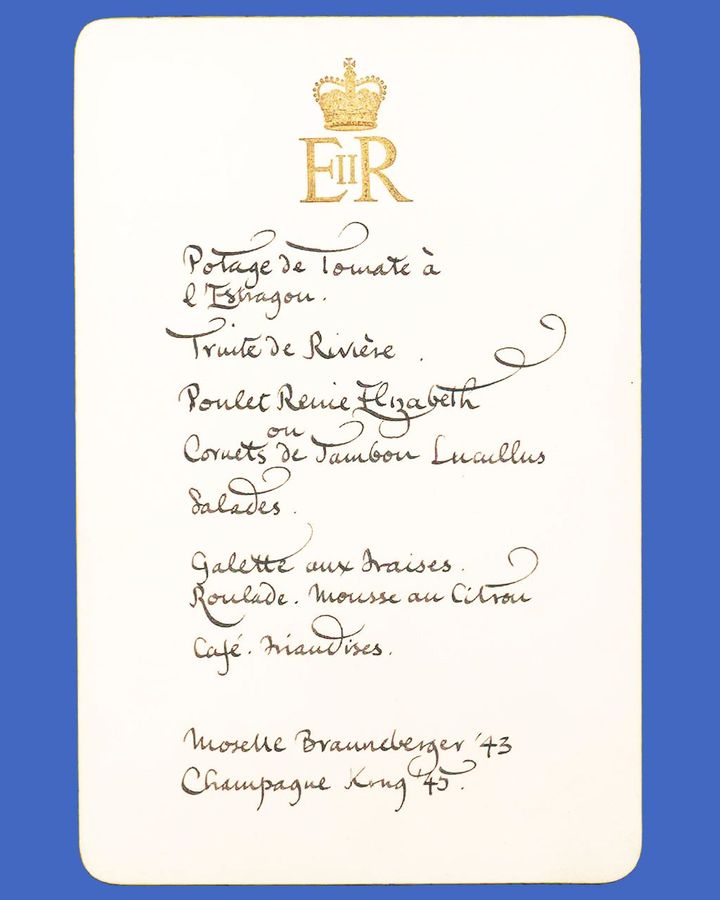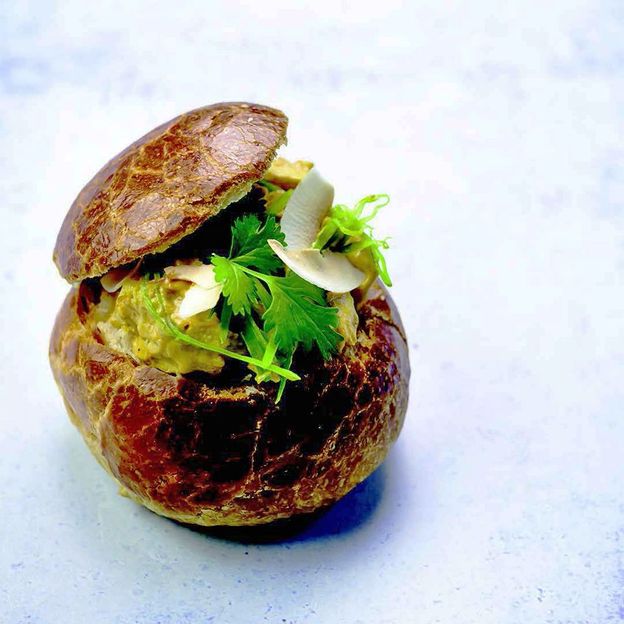Invented for a luncheon during the coronation of Queen Elizabeth II in 1953, coronation chicken is a dish of diced chicken with a creamy sauce and touch of curry powder that has endured – and evolved – in British cuisine for 70 years. But how did it all begin and how might one find it today, especially in light of the upcoming coronation of Charles III and Camilla on 6 May?
In 1953, the Minister of Works asked Le Cordon Bleu London culinary school – run by Constance Spry, a celebrated florist, and Rosemary Hume, a cook and author – to serve lunch at Westminster School for 350 foreign representatives invited to attend the coronation. As students were serving the food, and the kitchen at the venue was too small to produce anything hot except for soup and coffee, the menu had to be simple but also appropriate for such a historic event.
Out of this was born coronation chicken, or as it was listed on the menu, "Poulet Reine Elizabeth". Served cold, the original recipe involved poaching chicken in water and wine before coating it in a creamy sauce consisting of mayonnaise, whipped cream, apricot and tomato purée, curry powder, lemon, pepper and red wine. The dish was accompanied by a well-seasoned salad of rice, green peas and pimentos. Spry said she doubted any of those served the dish would have recognised it as a curry, instead describing it as having "a delicate and nut-like flavour".
The "other" coronation chicken?
Half a hollowed pineapple filled with Chicken a la King and garnished with Parmesan cheese, topped with a crown fashioned from an orange slice, cherries and shredded coconut. Created by the Poultry and Egg National Board for a 1953 "coronation chicken day" in New York in advance of Queen Elizabeth II's coronation, this recipe might be the very first coronation chicken.
According to Freya Perryman, communications officer from Le Cordon Bleu London, "The recipe was created by Rosemary Hume and Constance Spry, with the main credit going to Hume, and we understand that students helped to fine-tune."
Exactly where the inspiration for the dish came from is a matter of speculation. Supposedly created for the Silver Jubilee of George V in 1935, a dish called Jubilee Chicken made with chicken, mayonnaise and curry powder is often said to be a precursor, but there's very little evidence for this theory. Griselda Barton, Hume's niece, is quoted in author and food historian Sue Shephard's 2010 book, The Surprising Life of Constance Spry, as saying the main inspiration came from a recipe for Queen Adelaide's favourite sandwich in the 1886 cookbook Savouries à la Mode by Harriet Anne De Salis. The recipe for Adelaide Sandwiches does include the diced breast of a fowl and is spiced with cayenne pepper, but, as food historian Annie Gray told me, "There is very little resemblance [to coronation chicken]."
Although coronation chicken is now famous as a sandwich filling, at the time of its creation it would have been a luxury. In 1953, post-World War Two rationing was still in place in the UK, and it was some time before chicken became an everyday ingredient. The recipe was first shared in the Constance Spry Cookery Book, published in 1956, but it didn't really establish itself as a fixture of buffets and dinner parties until the 1970s and '80s.
According to food historian Sam Bilton, "coronation chicken did become a more affordable dish to make, although modern iterations are quite different from Spry & Hume's delicately spiced chicken dish."

Coronation chicken was listed on a 1953 coronation menu as "Poulet Reine Elizabeth" (Credit: Le Cordon Bleu London)
As early as 1980, recipes can be found that include seedless grapes, while sultanas were often included in stripped-back versions with little more than chicken, mayonnaise and curry powder. Many British celebrity chefs have also added their own twist to it over the years, including Heston Blumenthal, who was invited to recreate the dish – adding other spices, sultanas and nigella seeds – for Queen Elizabeth II's Diamond Jubilee garden party in 2012.
Seventy years after its invention, coronation chicken is still ubiquitous across the United Kingdom and can often be found in sandwiches in the largest supermarkets and the smallest cafes. Perryman illustrated its enduring appeal by explaining, "This dish carries a sentimentality that makes people think of picnics and street parties. It's also so accessible. You can adjust the spices, change the protein, use it in a salad or elevate the recipe for a dinner party. The dish has remained a proud part of our history at the institute, and we love to see how often it has been reimagined by a variety of chefs over the years."
Asked how Le Cordon Bleu London will be marking this year's Coronation, Perryman said, "At Café Le Cordon Bleu and CORD Café, we will be offering a gourmet coronation chicken bun [see recipe below] and a delicious fruit tart complete with crown decoration. At CORD Restaurant, the menu will feature a three-course set menu in celebration of King Charles III, comprised of his food favourites and considering His Majesty's own ethos around sustainability and provenance."
She continued, "This special menu will include the Coronation Lamb; a beautiful dish of organic British lamb with forest mushrooms, comprised of seared lamb loin, dry slow-roasted crispy shoulder, slow-cooked porcini mushroom and pancetta compote, pickled girolles, garlic cream, lamb jus and savoy cabbage. The dish has been created for CORD by Chef Emil Minev, Director of Culinary Arts at Le Cordon Bleu London."

Café Le Cordon Bleu and CORD Café's coronation chicken bun (Credit: Le Cordon Bleu London)
Coronation Chicken Buns recipe
By Le Cordon Bleu London's Master Chefs
Serves 2
Ingredients
1 smoked chicken breast, finely diced
2 spring onions, finely sliced
2g (½ tsp) mild curry powder
2g (½ tsp) ground turmeric
60g (¾ cup) mayonnaise
15g (¼ cup) crème fraîche
5g (1 tsp) tomato ketchup
15g (¼ cup) apricot nappage (sieved jam)
juice of 1 lime
salt and pepper
small bunch coriander leaves, plus extra leaves for serving
50g (½ cup) mangetout (snow peas)
2 brioche buns
20g (about ¼ cup) coconut flakes
Method
Step 1
Place prepared chicken breast and spring onions in a large bowl. Sprinkle over the curry powder and ground turmeric. Add the mayonnaise, crème fraiche, tomato ketchup, apricot nappage and lime juice and stir to combine. Season with salt and pepper.
Step 2
Roughly chop the coriander leaves. Add to the chicken mixture and stir to coat in the sauce.
Step 3
Remove the tops and tails from the mangetout and thinly slice on an angle.
Step 4
Slice the brioche buns lengthwise and set the tops aside. Scoop out the inside, being careful not to break the bun crust. Fill the scooped hole with the chicken mixture and top with a little mangetout, coconut flakes and coriander leaves. Replace the top bun and serve immediately.
You can find out more about each of the coronation recipes below, including tips on making them:
More coronation recipes:
- Chef Mark Flanagan's Coronation quiche
- Nadiya Hussain's Coronation aubergine
- Ken Hom's Coronation roast rack of lamb
- Adam Handling's Coronation trifle
- Gregg Wallace's prawn tacos with pineapple salsa
- Martha Collison's Coronation crown scones
- Claire Ptak's brown sugar Victoria Sponge
BBC.com's World's Table "smashes the kitchen ceiling" by changing the way the world thinks about food, through the past, present and future.
---
Join more than three million BBC Travel fans by liking us on Facebook, or follow us on Twitter and Instagram.
If you liked this story, sign up for the weekly bbc.com features newsletter called "The Essential List". A handpicked selection of stories from BBC Future, Culture, Worklife and Travel, delivered to your inbox every Friday.
"behind" - Google News
April 30, 2023 at 10:25PM
https://ift.tt/3AOxSBf
Coronation chicken: The story behind the royal dish - BBC
"behind" - Google News
https://ift.tt/bLH7EUf
https://ift.tt/K3uiPs4
Bagikan Berita Ini














0 Response to "Coronation chicken: The story behind the royal dish - BBC"
Post a Comment